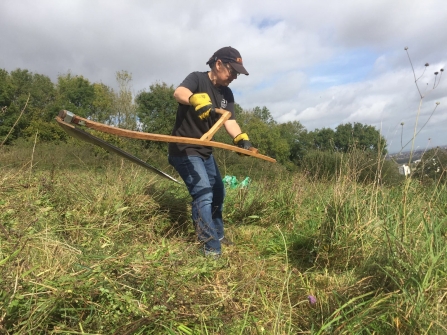At Avon Wildlife Trust we have a similar seasonal rush, albeit on a smaller scale. Many of the sites we manage contain areas of wildflower grassland or hay meadows, rich in biodiversity but low in agricultural productivity. Because of changes in modern farming practice since the Second World War, many of the most important sites for nature conservation have been pushed to the edges of the agricultural landscape. These include limestone ridges on poorly accessible slopes or in the watery rhynes (ditches) that divide the fields across the Gordano valley. As Bristol expands, so remnant meadows and woodlands are incorporated into the fabric of our city too. It’s not difficult to find areas teeming with wildflowers and insects within the city itself, and we need to manage these spaces appropriately to ensure they go on providing a peaceful escape for us and ecological security for decades to come.
Hay meadows are botanically diverse and support a wealth of insect life including bumble bees, moths, butterflies and other insects like the beautiful violet oil beetle. Some of our most striking native flowers like orchids, trefoils, scabious and wild herbs like thyme and marjoram are reliant on these habitats and the traditional management techniques for their survival. Without the action of grazing animals cropping the grass or annual cutting by people, the meadows would soon lose their species diversity and the complex food webs that result.
The use of a traditional Austrian scythe is a fun and environmentally friendly method for manging this habitat, particularly in urban areas where access for tractors is difficult. The physical motion of scything, a rhythmic and powerful sweep that slices the tall stems of the grass sward, takes some practice. Once mastered however, it is one of the most enjoyable and cathartic activities I know of. Through the My Wild City project – which focuses on creating wildlife-rich spaces in Bristol neighbourhoods and across our region - we have taught many groups of volunteers to use the scythe. Our volunteers are always passionate about nature conservation and doing their bit to help, but many also benefit from this activity because it is a wonderfully satisfying task that relieves stress, builds up strength and stamina and allows people to socialise whilst learning a new (but very old) skill.
It’s a particularly sensory activity. Liberated from the drone of petrol powered machines, a troop of scythers can tune into their surroundings. A family group of long-tailed tits, moving from hawthorn to rose bush, sampling the bounty of berries and seeds of late summer; or the fragrance of sweet cut grass, mixed in with the scent of sliced marjoram. To have a positive relationship with nature is to slow down and appreciate these things.
If you’re interested in volunteering with Avon Wildlife Trust, we’d love to hear from you avonwildlifetrust.org.uk/get-involved/volunteering-opportunities


